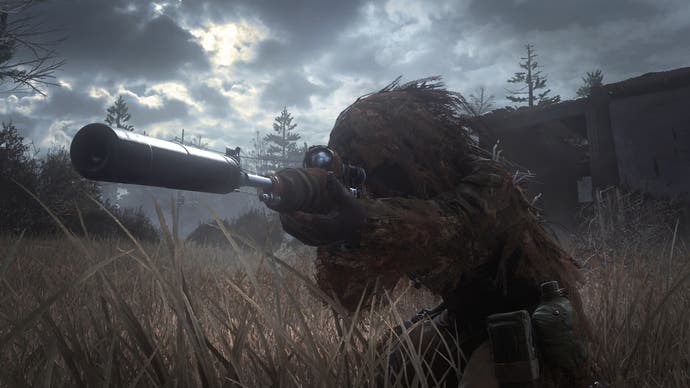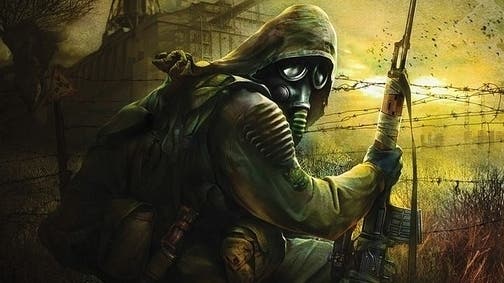How Chernobyl cast its shadow over video games
Call of Pripyat.
"50,000 people used to live here. Now it's a ghost-town."
The camera tilts upward, revealing a flyover view of a city, the image desaturated and grainy, as if recorded on a 90s camcorder. We see tower-blocks, trees, and behind them both, a Ferris wheel silhouetted against a slate-grey sky. The camera moves closer to the wheel, which is now revealed to be flaking with rust. As the camera tracks upward from the wheel's base, four words are spelled out in night-vision green. "Pripyat, Ukraine. Chernobyl outskirts."
This was the world's first glimpse of Modern Warfare, the game which transformed Call of Duty - already a successful franchise, into the AAA behemoth that it remains today. I've always been fascinated by the decision-making process which led to that trailer being structured in that way. Call of Duty 4 is a game which features daring black-ops raids, contemporary middle-eastern conflicts, atomic explosions. And yet Activision decided that the first thing the world saw of a game titled Modern Warfare would be a Soviet city abandoned in 1986.

It's a decision that says a lot about the power of Chernobyl, and the dark mystique it has in the collective consciousness. Video games invoke Chernobyl with surprising (perhaps alarming?) regularity. Chernobyl has been unusually influential in gaming, both as a direct inspiration for specific games, and indirectly through ideas borrowed those foundational titles.
The main instigator in all this in this is S.T.A.L.K.E.R: Shadow of Chernobyl, GSC Game World's semi open-world shooter from 2006. Shadow of Chernobyl draws from a number of influences, primarily the science-fiction novel Roadside Picnic, and Andrei Tarkovsky's loose 1977 adaptation Stalker, both of which are about groups of people attempting to retrieve valuable artefacts from a dangerous exclusion zone.
Shadow of Chernobyl takes this core idea and adapts it to the real exclusion zone surrounding the nuclear power-plant. From a perspective of play, the presence of Chernobyl has little bearing on the game. All of its most significant mechanical ideas are taken from Stalker and Roadside Picnic, that notion of scavenging anomalous materials for profit from a strange and dangerous environment. Players don't actually see the power plant itself until right at the end of the game.

Yet adding the idea of Chernobyl specifically into the heads of players makes the premise both simultaneously more tangible and more mysterious. Games themed around nuclear disasters have been around since Missile Command. Both Wasteland and Fallout dealt with exploring a dangerous, irradiated landscape many years before S.T.A.L.K.E.R did.
So what makes Chernobyl different? The answer, as is also demonstrated by the recent, astonishing HBO miniseries, is that Chernobyl is about far more than the nuclear disaster. Its significance is not merely scientific. It is also cultural, humanitarian, environmental, even architectural. The brutalist tower blocks of Pripyat, the dilapidated villages inside the exclusion zone, partly reclaimed by nature, the military cemetery filled with rusting trucks and discarded Hind helicopters, are all as much a part of Chernobyl as its ominous red-and-white chimney stacks.
Macabre as it may be, Chernobyl has become an aesthetic, or perhaps a better word would be atmosphere. It's one of eerie winds rustling through brown forests, of clicking Geiger-counters, crumbling concrete and flaking metal, of leaden skies and above all, silence. It's a place where the usual distractions from the moment are almost entirely absent, and your own senses are heightened by the knowledge that there is literally something in the air.
For video games, such an atmosphere is irresistible, as it ensures the player is never a passive observer in the world you create. GSC Game World's adaptation of the Chernobyl exclusion zone provides the perfect blueprint for how to immerse the player in a place, and you can measure its success by by counting the games marked by its influence, whether that's the Metro series, Survarium, Fear the Wolves, The Signal From Tolva, and of course, Modern Warfare. Even the later Fallout games owe a debt to S.T.A.L.K.E.R.

But there's more to this than style. Chernobyl is a place that exudes mystery and strangeness, partly due to the effects radiation can have on biological systems (effects both physical and psychological) and also due to the shroud of secrecy the Soviet Union laid over Chernobyl in the wake of the disaster. S.T.A.L.K.E.R, for example, includes its fair share of science fiction, but in an interview with Rock, Paper, Shotgun, creative director Anton Bolshakov explained how those concepts were taken from "real" conspiracy theories about the power plant, such as the plant being a base for secret laboratory experiments, or that the giant military antennae located in the zone emitted "psycho-active" waves to influence human behaviour in the West.
Sometimes the facts are even stranger than the fiction. Take Modern Warfare, for example. Those fleeting images shown in the trailer are revealed in the game to be part of a flashback stretched over two missions. You, in the role of Captain Price, are guided by a superior officer named MacMillan through the exclusion zone, as you prepare to assassinate the game's primary antagonist, Imran Zakhaev.
It's a tense and brilliantly choreographed bit of virtual military drama. But there's one thing Modern Warfare doesn't mention. In Modern Warfare's fiction, the mission takes place in 1996. At that time, two of Chernobyl's four reactors were still in operation.
After reactor number four exploded in April 1986, reactor number one was not shut down until November 1996, after considerable international pressure upon Ukraine to begin decommissioning the plant. Reactor number three continued operating for a further three years, finally shutting down in December 1999. As for reactor number two, Ukraine was comparatively quick off the mark. It shut down in 1991, but only after the turbine building at the number 2 site caught fire.

Did Infinity Ward know about this? If they did, why did they omit it? Surely it's something you would mention in your high-octane action game, if for no other reason than to add some extra spice to your doomsday scenario. Then again, maybe it lessens the fantasy. You can't have nuclear scientists stumbling into your terrorist arms sale - that's sure to ruin the mood. Part of Chernobyl's mythos is the understanding of it as a dead zone, a place that normality has abandoned.
Mythos is the appropriate word here, because this notion is one of the biggest myths about Chernobyl today. In the years since the surrounding area was evacuated, wildlife has flourished in Chernobyl's exclusion zone. Far from being infested with irradiated mutants as portrayed in S.T.A.L.K.E.R, Chernobyl is instead home to over 200 bird species, high populations of amphibians, and large mammals including, bison, brown bears, lynx, wolves, and wild horses. The effects of the radiation upon these animals is not quite negligible, but it is far less than what scientists originally predicted.
With every day that passes, Chernobyl becomes less a warning about what happens when nuclear power goes wrong, or the consequences of ideological totalitarianism, and more of an indictment about humanity's impact on the planet If an irradiated, biological no-go area has a greater biodiversity than our own “natural” countryside, surely that must be a wake-up call to the monstrous damage we're inflicting upon the environment?
Video games are far from done with Chernobyl. This autumn will see the launch of Chernobylite - a survival-horror shooter that vocally brags about its heritage, while S.T.A.L.K.E.R 2 is scheduled to launch in 2021. There's little info on S.T.A.L.K.E.R 2 at the moment, but for a long-time S.T.A.L.K.E.R fan, Chernobylite certainly looks like it's help make the wait for a true sequel that little bit less painful.
I wonder, however, whether it's time to move away from this notion of Chernobyl as the haunted sarcophagus, a cursed MacGuffin that exists to be chased. Instead, I'd like to see games that explore the changing significance of the Chernobyl Exclusion Zone, emphasising less the danger Chernobyl poses to humanity, and more the danger humanity poses to Chernobyl.

